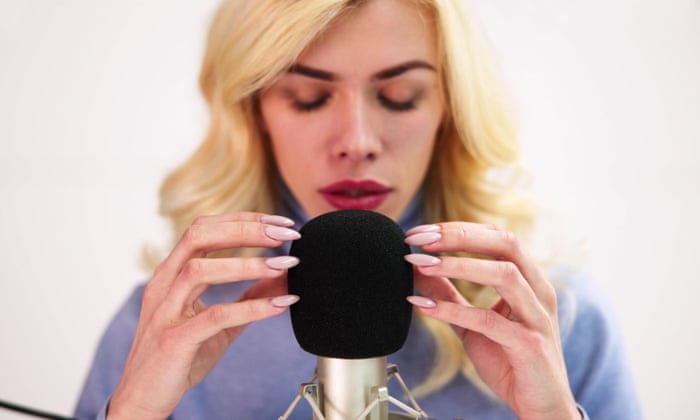
Youthful adults are more and more overwhelmed by in-person interplay and soothing themselves as a substitute with sensory on-line content material, in response to a report on the wildly in style on-line content material often known as ASMR.
ASMR – autonomous sensory meridian response – describes a selected sensory phenomenon that’s triggered by particular sights or sounds, which normally begins with a tingling sensation throughout the scalp and ends in emotions of deep calm and rest.
Platforms akin to YouTube and TikTok are filled with 1000’s of those visceral movies, through which ASMR creators play with squishy slime, role-play braiding the viewer’s hair, whisper loving affirmations or paint the digicam lens with spit, all geared toward stimulating these “tingles”.
Now the award-winning behavioural insights company Revealing Actuality has revealed a landmark report on the phenomenon, interviewing viewers and creators of ASMR content material and analysing 1000’s of movies based mostly on widespread triggers – akin to exaggerated whispering, respiration and mouth sounds, tapping and crinkling sounds, light or fluttering hand actions – which many individuals use to assist them unwind and sleep.
However the researchers observe their “shock” on the “considerably greater” charges of youthful individuals who mentioned they discovered face-to-face interplay and noisy public locations overstimulating, and query what the rising enchantment of ASMR movies for this cohort reveals about their means to navigate the messy unpredictability of offline life.
In a survey of greater than 2,000 adults, Revealing Actuality discovered an in depth correlation between age and sensitivity to each social and sensory stimuli: youthful adults, aged 18-44, usually tend to discover the world overstimulating, to wish to defend themselves from exterior noise and face-to-face interactions in addition to reporting higher enjoyment of ASMR.
In some circumstances, the age variations have been pronounced:
-
47% of these aged 25-34 mentioned they felt overwhelmed in noisy or busy locations akin to buying centres or prepare stations, in contrast with 35% of these aged 55-64.
-
39% of these aged 18-24 felt the necessity to shut out noise, for instance utilizing noise-cancelling headphones in public, in contrast with solely 21% of these age 45-54.
-
Youthful age teams have been additionally extra more likely to choose chatting to individuals on-line relatively than nose to nose and to choose to work alone relatively than round different individuals.
The analysis comes as audiologists elevate issues about a rise in younger individuals referred to them with auditory processing issues, which can be linked to the overuse of noise-cancelling headphones.
However with information from the UK and the US exhibiting that, in contrast with earlier generations, younger individuals are spending much less day trip on this planet and experiencing extra nervousness, the report additionally questions the influence on those that “shun the messy unpredictability of in-person interplay and attempt to meet all their human wants by means of a display screen”.
In detailed interviews, customers of ASMR content material clarify the consolation and pleasure they take from it: the “visceral calming” and “escapism”, from a world that’s “an excessive amount of”, and the place even a stranger showing to provide you their full consideration is “a luxurious expertise”.
However the researchers query whether or not ASMR is “like digital soma” for “rising numbers of younger individuals in search of to fulfill their pure want for consolation and connection, for tactile experiences and messy play, for intimacy and a spotlight” by means of these “artificial” experiences.
“What if we overlook that typically it’s good for us to do issues that really feel exhausting? What if, in shying away from the messiness of embodied human interactions, we miss out on issues we want as people and as a species – pheromones, non-verbal communication, adaptability, emotional development.”
Likewise, they query whether or not life actually is extra overwhelming than it was once, or whether or not by “opting out of its extra abrasive points” individuals are lowering their means to take care of them.
Jenny Radesky, an affiliate professor on the College of Michigan and professional within the interplay of know-how and baby growth, mentioned the report supplied a possibility to replicate on how younger individuals constructed resilience. “If life feels overwhelming then ASMR is a simple, quick, accessible useful resource that calms them down with out having to do the work demanded, for instance, by practising respiration workout routines or mindfulness.”
The problem was that ASMR calmed however didn’t essentially allow younger adults to reconnect with the broader world, she added. “Studying abilities to use at different instances in your life just isn’t normally an specific a part of ASMR. Should you’re depending on this content material and also you all the time must entry it to really feel higher, that could be a drawback for creating these abilities independently. We want different choices in younger individuals’s actual world, their social and bodily context, so that there’s extra potential to study resilience.”









